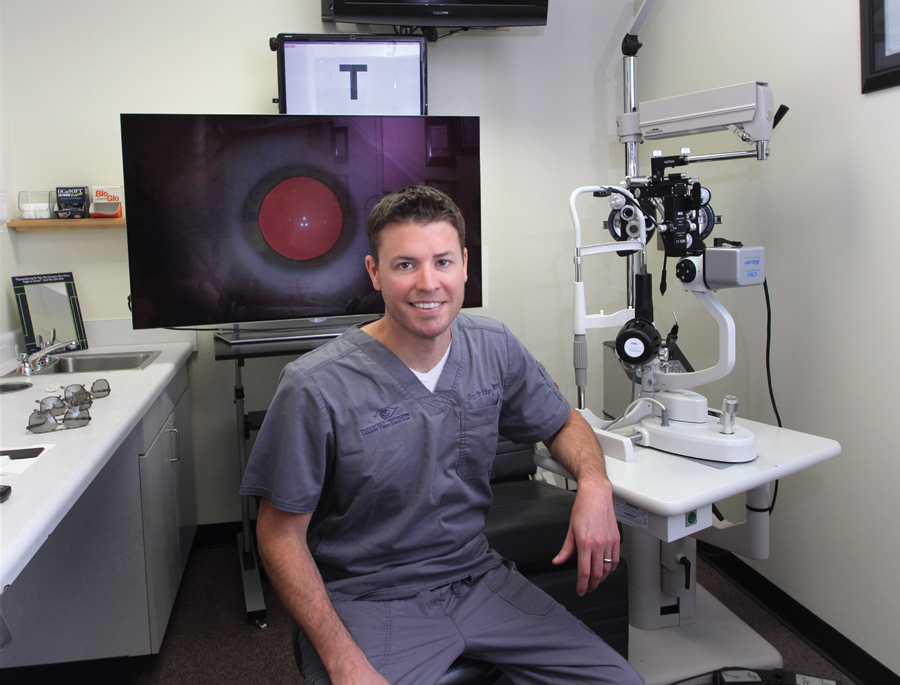Dr. Gregory Parkhurst is a prominent ophthalmological surgeon, and the founder/medical director of Parkhurst NuVision clinic. The clinic shares a building in the Medical Center with the University of the Incarnate Word School of Optometry, where Parkhurst is an adjunct professor.
A native of Michigan, Parkhurst received his M.D. from Northwestern University in 2003 and pursued residency training in eye surgery at the Walter Reed Army Medical Center. After serving in the United States Army for eight years and treating numerous soldiers returning from Iraq, he continued his training through a subspecialty fellowship in refractive eye surgery at the University of Texas Health Science Center at Houston.
The youthful doctor has received national and international recognition for his innovative work, including being named one of the Top 40 Under 40 Most Influential Ophthalmologists by the European journal Ophthalmologist. He has often been the first surgeon to perform a new type of surgery or the one who performed the greatest number of procedures based on a new technology. The recipient of multiple professional awards, he currently serves as the president of the international Refractive Surgery Alliance Society, something he is especially proud of. Also gratifying was to see Parkhurst NuVision listed as one of the top places to work for in San Antonio. Married and the father of three children, Parkhurst and his family originally came to Texas when he was stationed at Fort Hood and later decided to settle in San Antonio.
Right now, NuVision is planning a substantial expansion that will increase the clinic’s space from the current 7,000 to 26,000 square feet
How would you describe what you do?
We help patients to see the world uninhibited by the barriers of poor vision and prosthetic eyewear, which is to say, without glasses or contact lenses.
What services does Parkhurst NuVision offer?
Vision correction surgery. LASIK is one procedure that most people know about, but we perform eight different procedures. Another common one is laser refractive cataract surgery. Some others are dysfunctional lens replacement, implantable contact lenses, and other correction procedures similar to LASIK, such as PRK and S.M.I.L.E.
LASIK is mostly used to correct myopia or nearsightedness. Why is myopia so widespread?
It’s a worsening global epidemic. It has to do with genetics and, we believe, environmental factors. Some research indicates that kids spending less time outdoors is a risk factor for developing myopia. There are certain countries, especially in Asia, where 90 percent of the population has myopia. Based on a study published in [the journal] Ophthalmology, myopia is projected to affect almost half of the world’s population by 2050. There are studies looking at other risk factors.
Not everyone who is nearsighted is a good candidate for LASIK. What else is available for those who do not qualify?
The best time to perform a LASIK procedure to correct distance vision is after ocular maturation occurs; when a child is grown up and vision no longer changes. However, LASIK cannot work for those who have very high myopia needing corrections greater than -9 diopters, or for those who have a thin cornea. For them, we have implantable contact lenses. “We can replace the natural eye lens with a new lens. With younger people, however, we insert an implantable lens but we do not remove anything. For older people, the dysfunctional lens is replaced (to eliminate presbyopia or cataracts). Almost everyone can be helped today. It’s very rare to encounter someone who doesn’t qualify for anything, including people over 40 who experience reading difficulties.
Tell us about your own experience?
I was a third grader when I got my first pair of glasses and I hated them. In junior
Let’s talk about cataracts, which affect just about everyone after a certain age. Are there people who don’t qualify?
Only those who have another eye condition that may cause blindness, such as macular degeneration or severe diabetic eye disease. Cataract surgery would not help them. Generally speaking, however, people are having cataract surgery earlier in life these days because technology has advanced so much that risks have gone way down. In the 1980s and before, the surgery did not involve implanting a new lens so people had to wear Coke-bottle glasses following cataract removal. It’s completely different now. Not only do we replace the lens,
How did you decide to become an ophthalmological surgeon?
When I first got glasses (in his hometown in Michigan), I hated my glasses but I liked my doctors. They were involved in the community, sponsored the Little League team for example, and I idolized them. Back then, I thought it would be a great profession to go into. So, in
Do you still go on missions?
Yes. Every January, I go to Mexico with a small team and a doctor from Fort Wayne, Indiana, and we stay for two weeks.
The people find out that there is a service like this coming up and they undergo a screening process by the local doctor. This is in a Mayan village in the Yucatan Peninsula. Then they line up in the hope that we can help them. We are able to perform about 15 operations a day. It’s an incredibly gratifying experience, to be able to perform a 20-minute operation on a completely blind person and to have them see again the day after! There are even young men with cataracts over there. Since the man is the breadwinner in that culture, if he is blind, the whole family is impacted.
We are enrolling for one right now. What we are looking at is a procedure called iDose, a surgical procedure for glaucoma. There is already an FDA-approved device called
Is your wife, Heather, involved with your practice in any way?
Yes, she is. As we expand into our new space, we are adding services to include a laser med spa. My wife will be running the med spa, which will perform non-surgical procedures like Ultherapy, for instance. It uses ultrasound to tighten skin.
Find out more about your San Antonio LASIK options now at the Parkhurst NuVision website.
Dr. Parkhurst comments have been edited for publication.
By Jasmina Wellinghoff
Photography by Janet Rogers










0 Comments